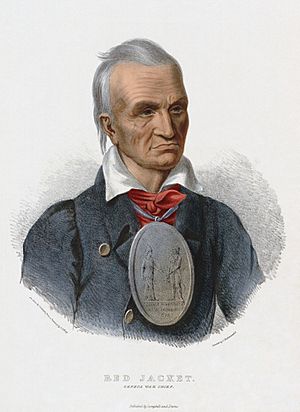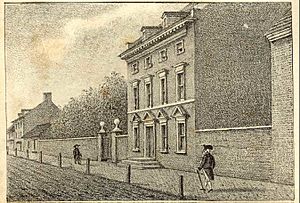Red Jacket facts for kids
Quick facts for kids
Red Jacket
|
|
|---|---|
| Otetiani, later Sagoyewatha | |

Red Jacket from an 1835 lithograph by Henry Corbould, after a painting by Charles Bird King, printed by Charles Joseph Hullmandel, and published in History of the Indian Tribes of North America
|
|
| Tribal chief of the Wolf clan | |
| Personal details | |
| Born | 1750 |
| Died | January 20, 1830 |
| Resting place | Forest Lawn Cemetery, Buffalo, New York, U.S. |
| Military service | |
| Allegiance | Seneca nation |
Red Jacket (born Otetiani, later known as Sagoyewatha [Keeper Awake]) (around 1750–January 20, 1830) was a famous Seneca speaker and chief of the Wolf clan. He lived in Western New York. After the American Revolutionary War, he spoke for his people. The Seneca had been allies of the British. When the British lost, the Seneca had to give up a lot of their land. Red Jacket helped negotiate with the new United States. He signed the Treaty of Canandaigua in 1794. He worked to keep some Seneca land in New York state.
Red Jacket's speech "Religion for the White Man and the Red" (from 1805) is a great example of his speaking style.
Contents
A Leader's Early Life
Red Jacket's exact birthplace is not fully known. Some historians think he was born around 1750 near what is now Geneva, New York. Others believe it was near Cayuga Lake or Keuka Lake. We do know he grew up with his family near Basswood Creek.
The Iroquois people, like the Seneca, had a matrilineal system. This means family lines and social status came from the mother's side. Red Jacket was part of his mother's Wolf Clan.
Red Jacket spent most of his adult life in the Seneca lands of the Genesee River Valley in western New York. He became known for his powerful speeches, defending the rights of his people.
Meeting George Washington
After the American Revolutionary War, Red Jacket played a big part in talks with the new United States government. In 1792, he led a group of 50 Native American leaders to Philadelphia. There, President George Washington gave him a special "peace medal." This large silver medal showed Washington shaking Red Jacket's hand. It also had their names and the year 1792.
Red Jacket wore this medal in every picture painted of him. For many years, the medal was kept at the Buffalo History Museum. In 2021, it was returned to the Seneca Nation. It is now at the Onöhsagwë:De’ Cultural Center, also known as the Seneca-Iroquois National Museum.
He also received a fancy rifle with his initials and Wolf clan symbol.
Land Treaties
In 1794, Red Jacket and other Iroquois leaders signed the Treaty of Canandaigua. This treaty made peace with the United States. But it also meant the Seneca had to give up a lot of their land. This happened because their British allies lost the war. Britain had given up its claims to land in the colonies without asking the Iroquois.
In 1797, another agreement, the Treaty of Big Tree, led to more Seneca land being sold. Red Jacket tried to stop this sale, but he couldn't convince the other chiefs.
Red Jacket and the War of 1812
Red Jacket got his name from a special red coat given to him by the British. The Seneca had sided with the British during the American Revolution. They hoped the British would help them keep their lands from American settlers. After the British lost, the Seneca had to give up much of their land. Many Seneca people moved to Canada.
However, in the War of 1812, Red Jacket supported the American side.
Ambush at Chippawa
Red Jacket helped the American forces in the Battle of Chippawa. He came up with a plan to ambush the British and their allies. He led 300 Seneca warriors. Peter B. Porter joined him with about 250-300 American militia and soldiers.
Their combined force moved quietly through the woods. They got close to the enemy without being seen. Red Jacket's Seneca warriors formed the front lines of the attack. They wore white handkerchiefs on their hats so the Americans could tell them apart from the enemy.
When they were in position, they surprised the enemy with heavy gunfire. Many of the enemy fell. Then, the Americans and Senecas charged, fighting hand-to-hand. The British and their allies were shocked and confused. They retreated into the woods.
After the main battle of Chippawa ended, all British forces pulled back. Red Jacket and Porter returned to check the battle site before leaving the area.
Later Life and Legacy
Around 1780, the Seneca gave him the name Sagoyewatha, meaning "he keeps them awake." This was because of his amazing speaking skills.
Speech on Religion
In 1805, a missionary named Mr. Cram wanted to do mission work among the Seneca. Red Jacket gave a famous speech called "Religion for the White Man and the Red." In this speech, he explained his deep belief that Native American religion was right for the Seneca people. He said that the Seneca had suffered a lot from Europeans.
Red Jacket argued that European Americans and Native Americans should each have the right to follow their own religions. He said that the Great Spirit had made everyone, but had made differences between white and red children. He believed that the Great Spirit had given different religions to different people.
He explained that his people's beliefs were similar to the missionary's, just with different names for the creator. He questioned why, if the white man's sacred book was for everyone, it hadn't been given to his ancestors. Red Jacket wished his visitors well and hoped the Great Spirit would protect them.
Final Resting Place
In his later years, Sagoyewatha lived in Buffalo, New York. When he died, he was first buried in an Indian cemetery. Later, in 1884, his remains were moved to Forest Lawn Cemetery, Buffalo. A memorial to Red Jacket stands in Seneca Indian Park.
Many portraits were painted of Red Jacket by famous artists like George Catlin and Henry Inman.
Honors and Legacy
Many places and things have been named after Red Jacket, especially in the Finger Lakes region and Buffalo:
- A group of dorms at the University at Buffalo
- Red Jacket Dining Hall at SUNY Geneseo
- The Red Jacket Building in Buffalo
- A statue and Red Jacket Park in Penn Yan, New York
- Red Jacket Yacht Club on Cayuga Lake
- The Red Jacket clipper ship, which set a speed record
- A public school system, Red Jacket Central
- The Red Jacket Volunteer Fire Department
- A part of the Buffalo River (New York) called "Red Jacket Peninsula"
- Red Jacket Parkway in South Buffalo
Images for kids
-
Red Jacket wearing the "Peace Medal" given to him by George Washington. Portrait by Charles Bird King, ca. 1828, Colby College Museum of Art.
-
The Trial of Red Jacket, by John Mix Stanley, 1869.
-
Portrait by Thomas Hicks (1868), National Portrait Gallery
-
Chief Red Jacket, with Two Warriors, by George Catlin
See also
 In Spanish: Red Jacket para niños
In Spanish: Red Jacket para niños
- U.S. Constitution, Native American influence







